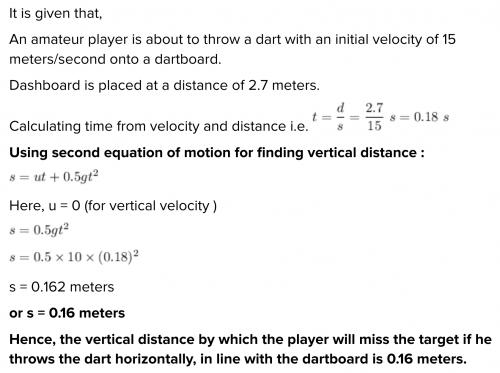 3
3 See explanation
Explanation:
Hookes law states that; the displacement due to a stretching force is directly proportional to the magnitude of the deforming force.
F = ke
F = deforming force
k = force constant
e = extention
k = F/e
k = 4N/0.06 m= 66.67 Nm^-1
To determine the extension of the spring produced by the 4.0 N weight
1) We measure the original length of the spring
2) We measure the length after hanging the 4 N mass
3) Subtract the new length from the original length to determine the extention.
 3
3 See explanation
Explanation:
Hookes law states that; the displacement due to a stretching force is directly proportional to the magnitude of the deforming force.
F = ke
F = deforming force
k = force constant
e = extention
k = F/e
k = 4N/0.06 m= 66.67 Nm^-1
To determine the extension of the spring produced by the 4.0 N weight
1) We measure the original length of the spring
2) We measure the length after hanging the 4 N mass
3) Subtract the new length from the original length to determine the extention.
 1
1  6
6 1. B) Increased confidence in human potential and individual worth encouraged ideas independent of traditional Church teachings.
During the Renaissance, Humanism replaced the strong religiosity of the European Middle Ages. Therefore, in many fields, like arts, politics, and science, the human intellect was boosted to explore and experiment with new ideas that were forbidden under the traditional Church teachings.
2. A) Renaissance thinkers encouraged individuals to question how things work, and scientists began to test these ideas with experiments during the Scientific Revolution.
During the Renaissance, artists and technicians gave great importance to the observation of reality, study of nature, and experimentation. This new way of experiencing reality independent from the bonds of religion and moral sparked the Scientific Revolution. Thanks to this environment, scientists like Galileo, who used a telescope for the first time, Kepler, and Tycho Brahe, made observations of the heavenly bodies that changed completely the way we understood how the universe works.
3. B) Scientists shifted from thinking about the world to trying to understand how it functioned.
During the Middle Ages, natural philosophers accepted without any doubt the theories about how the world works proposed by Aristotle millennia ago. All these theories were based on mere speculation, but the new Renaissance spirit pushed scientists to test these theories and try to understand what they were observing. It was the birth of the scientific method.
4. D) Newton's book argued that mathematical principles could be applied to our understanding of the natural world.
In Mathematical Principles of Natural Philosophy, Sir Isaac Newton argued that Mathematics is the language of nature and, therefore, every action in the natural reality could be understood through mathematical study.
5. B
He published On the Structure of the Human Body, which became the foundation of modern anatomy.
This book had a great impact on the study of human anatomy and Andreas Vesalius is considered one of the most important figures in medical research of all times due to this work.
6. A) Bacon's proposed use of inductive reasoning encouraged scientists to come to conclusions by way of data collection.
The British philosopher, Francis Bacon, is considered the father of empiricism. He made precise rules for the new experimental scientific method using inductive reasoning, which consisted of collecting individual data, look for patterns, and come to general conclusions or laws.
7. D) He noticed that everything in the natural world had mathematical properties, and they could be used to study and measure everything.
Johannes Kepler, who was a German mathematician, physicist, and astronomer, had a great influence from the Pythagorean school. According to this way of thought, everything could be reduced to numbers and arithmetical proportions and relations. Thus, Kepler restlessly looked for mathematical patterns in the order and motion of heavenly bodies.
8. B) Galileo's observations could prove Copernicus's theories about the order of the universe.
Galileo's observations through the telescope provided empirical proofs for the Copernicus' model, that stated that the Earth moves around the Sun, and not the other way around as the Church said. This was an affront to the authority of the Catholic Church, and for that reason, it wanted to silence Galileo.
9. C) Scientists now gathered information and facts before creating a theory.
Inductive reasoning consists of collecting particular data, look for the patterns that data shares, and come to general conclusions. For example, "John and Peter are men, John and Peter are mortal, therefore all men are mortal", the general conclusion here is "all men are mortal." Deductive reasoning is the opposite, it parts from general or universal law and then it is applied to particular cases. For example, the general law is "all men are mortal", since John and Peter are men, therefore, John and Peter are mortal.
 6
6 1. B) Increased confidence in human potential and individual worth encouraged ideas independent of traditional Church teachings.
During the Renaissance, Humanism replaced the strong religiosity of the European Middle Ages. Therefore, in many fields, like arts, politics, and science, the human intellect was boosted to explore and experiment with new ideas that were forbidden under the traditional Church teachings.
2. A) Renaissance thinkers encouraged individuals to question how things work, and scientists began to test these ideas with experiments during the Scientific Revolution.
During the Renaissance, artists and technicians gave great importance to the observation of reality, study of nature, and experimentation. This new way of experiencing reality independent from the bonds of religion and moral sparked the Scientific Revolution. Thanks to this environment, scientists like Galileo, who used a telescope for the first time, Kepler, and Tycho Brahe, made observations of the heavenly bodies that changed completely the way we understood how the universe works.
3. B) Scientists shifted from thinking about the world to trying to understand how it functioned.
During the Middle Ages, natural philosophers accepted without any doubt the theories about how the world works proposed by Aristotle millennia ago. All these theories were based on mere speculation, but the new Renaissance spirit pushed scientists to test these theories and try to understand what they were observing. It was the birth of the scientific method.
4. D) Newton's book argued that mathematical principles could be applied to our understanding of the natural world.
In Mathematical Principles of Natural Philosophy, Sir Isaac Newton argued that Mathematics is the language of nature and, therefore, every action in the natural reality could be understood through mathematical study.
5. B
He published On the Structure of the Human Body, which became the foundation of modern anatomy.
This book had a great impact on the study of human anatomy and Andreas Vesalius is considered one of the most important figures in medical research of all times due to this work.
6. A) Bacon's proposed use of inductive reasoning encouraged scientists to come to conclusions by way of data collection.
The British philosopher, Francis Bacon, is considered the father of empiricism. He made precise rules for the new experimental scientific method using inductive reasoning, which consisted of collecting individual data, look for patterns, and come to general conclusions or laws.
7. D) He noticed that everything in the natural world had mathematical properties, and they could be used to study and measure everything.
Johannes Kepler, who was a German mathematician, physicist, and astronomer, had a great influence from the Pythagorean school. According to this way of thought, everything could be reduced to numbers and arithmetical proportions and relations. Thus, Kepler restlessly looked for mathematical patterns in the order and motion of heavenly bodies.
8. B) Galileo's observations could prove Copernicus's theories about the order of the universe.
Galileo's observations through the telescope provided empirical proofs for the Copernicus' model, that stated that the Earth moves around the Sun, and not the other way around as the Church said. This was an affront to the authority of the Catholic Church, and for that reason, it wanted to silence Galileo.
9. C) Scientists now gathered information and facts before creating a theory.
Inductive reasoning consists of collecting particular data, look for the patterns that data shares, and come to general conclusions. For example, "John and Peter are men, John and Peter are mortal, therefore all men are mortal", the general conclusion here is "all men are mortal." Deductive reasoning is the opposite, it parts from general or universal law and then it is applied to particular cases. For example, the general law is "all men are mortal", since John and Peter are men, therefore, John and Peter are mortal.
 6
6 The central claim of Benjamin Banneker's letter to Thomas Jefferson is:
C. Because of British oppression, Americans should understand the plight of slaves.Based on the given excerpt, we can see that Thomas Jefferson got a letter by Benjamin Banneker where he was urged to push for the freedom of slaves and remember their plight.
He made comparisons to their ordeal at the hands of the British to make his case for the slaves and for their freedom and the abolishment of slavery in America.
Therefore, the correct answer is option C
Read more about slavery here:
link
 6
6 The central claim of Benjamin Banneker's letter to Thomas Jefferson is:
C. Because of British oppression, Americans should understand the plight of slaves.Based on the given excerpt, we can see that Thomas Jefferson got a letter by Benjamin Banneker where he was urged to push for the freedom of slaves and remember their plight.
He made comparisons to their ordeal at the hands of the British to make his case for the slaves and for their freedom and the abolishment of slavery in America.
Therefore, the correct answer is option C
Read more about slavery here:
link


Independent variable: the best method to get rid of them.
Dependent variable: washing with soap and water.
Hypothesis: Organic oils
Control group: water

It will provide an instant answer!
